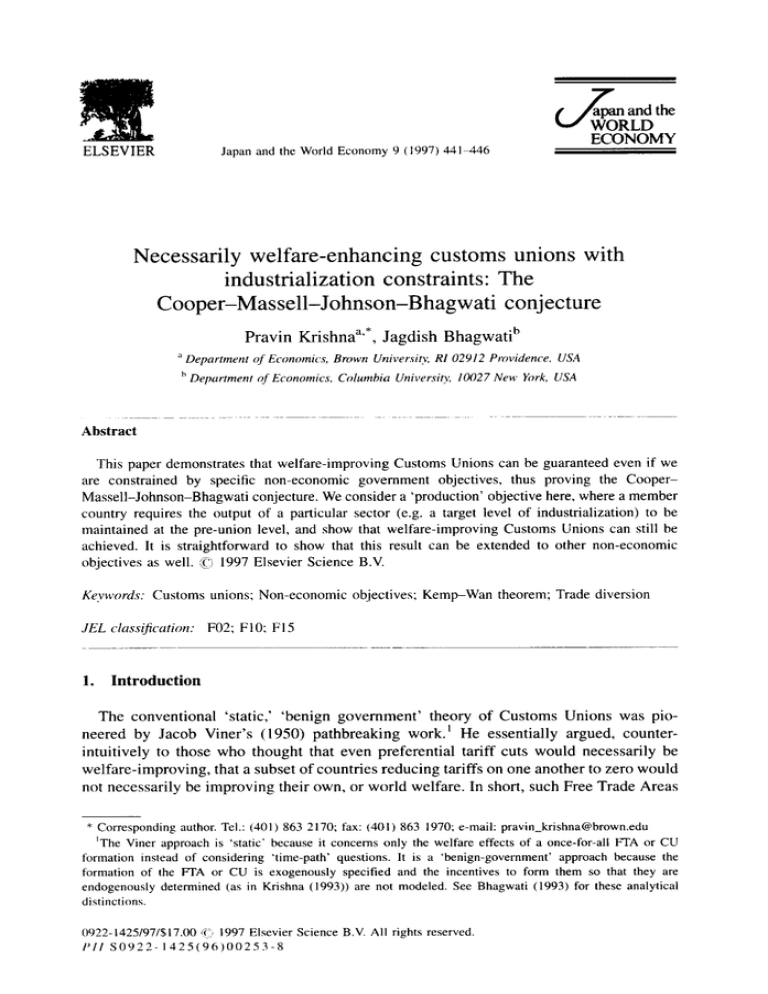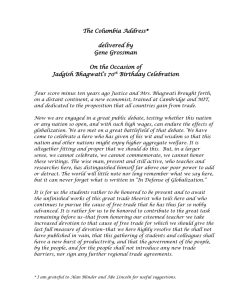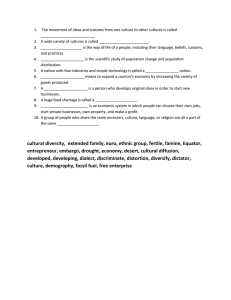
ECONOMY
ELSEVIER
Japan and the World Economy 9 (1997) 441~-46
Necessarily welfare-enhancing customs unions with
industrialization constraints: The
Cooper-Massell-Johnson-Bhagwati conjecture
•
a
m
Pravin Krlshna • , Jagdish Bhagwati b
a Department of Economics, Brown UniversiO; RI 02912 Providence, USA
b Department of Economics, Columbia University 10027 New York, USA
Abstract
This paper demonstrates that welfare-improving Customs Unions can be guaranteed even if we
are constrained by specific non-economic government objectives, thus proving the CooperMassell-Johnson-Bhagwati conjecture. We consider a 'production' objective here, where a member
country requires the output of a particular sector (e.g. a target level of industrialization) to be
maintained at the pre-union level, and show that welfare-improving Customs Unions can still be
achieved. It is straightforward to show that this result can be extended to other non-economic
objectives as well. (~') 1997 Elsevier Science B.V.
Kevwords." Customs unions; Non-economic objectives; Kemp-Wan theorem; Trade diversion
JEL classification."
1.
F02; F10; Fl5
Introduction
The conventional 'static,' 'benign government' theory of Customs Unions was pioneered by Jacob Viner's (1950) pathbreaking work. I He essentially argued, counterintuitively to those who thought that even preferential tariff cuts would necessarily be
welfare-improving, that a subset of countries reducing tariffs on one another to zero would
not necessarily be improving their own, or world welfare. In short, such Free Trade Areas
* Corresponding author. Tel.: (401) 863 2170; fax: (401) 863 1970; e-mail: pravin_krishna@brown.edu
~The Viner approach is 'static' because it concerns only the welfare effects of a once-for-all FTA or CU
formation instead of considering "time-path' questions. It is a 'benign-government' approach because the
formation of the FTA or CU is exogenously specified and the incentives to form them so that they are
endogenously determined (as in Krishna (1993)) are not modeled. See Bhagwati (1993) for these analytical
distinctions.
0922-1425/97/$17.00 ~ 1997 Elsevier Science B.V. All rights reserved.
P I I S 0 9 2 2 - 1 4 2 5 ( 9 6 ) 0 0 2 5 3-8
442
P. Krishna, J. Bhagwati/Japan and the WorldEconomy 9 (1997) 441~I46
or Customs Unions (with common external tariffs) could be trade-diverting and harmful or
trade-creating and beneficial.
Although there have been numerous important developments within this analytical
framework, including by Lipsey (1957), Lipsey and Lancaster (1956), Johnson (1962) and
Meade (1955), interesting developments in new directions have been made in two other
contributions:
1. Bhagwati and Brecher (1980) have considered a rather different type of problem: if a
Customs Union with internal factor mobility and a common external tariff is already in
place, how would parametric and policy changes (e.g. factor accumulation and tariff
change, respectively) affect the welfare of individual members countries? This
question is clearly of analytical importance for the European Union and indeed for a
federal state like the United States, if the regional welfare effects of such changes are
at issue.
2. Kemp et al. (1976) who have remained more properly within the Viner-Lipsey type of
question, however, have restored the original intuition that any subset of countries could
improve their welfare, while not lowering that of others by forming an appropriate
Customs Union. 2
There is an interesting conjecture attributable to Cooper and Massell (1965),Johnson
(1965) and Bhagwati (1968) that state that:
Any subset of countries can always form a welfare-enhancing Customs Union, while
ensuring that they still achieve the degree of industrialization that they had achieved
through protective tariffs 3
In this short note, we prove the proposition. In doing so, we re-prove the K e m p - W a n
proposition by using an optimization framework and then readily extend it, by adapting the
Bhagwati and Srinivasan (1969) analysis of non-economic objectives or constraints, to the
problem at hand.
2.
The Kemp-Wan theorem
As in Kemp et al. (1976), consider a competitive world trading system with any number
of countries and with no restrictions whatever on the initial tariffs of individual countries.
Let any subset of countries form a Customs Union. To see how aggregate gains for the
member countries can be achieved, we use the familiar Samuelson (1956) social
indifference curves, which enable us to write a well-behaved social utility function.
2In doing so, they solved for the common external tariff, therefore using it as an endogenously-determined
policy variable, unlike in the Viner-Lipsey approach.
3For instance, Cooper and Massell (1965) ask, "Why should a country be willing to give up its sheltered
industries for the partial benefits of a Customs Union?" and "Is there a tariff that would make both countries (in
a CU) better off relative to optimal policies of non preferential tariff protection?" and Bhagwati (1968) states
that "If LDCs could be allowed to reduce tariff barriers among themselves, this could permit the given trade
diversion (implicit in each LDC's decision to industrialize) to be carried out at a lower cost".
P. Krishna, J. Bhagwati/Japan and the World Economy 9 (1997) 441-446
443
We allow for the use of lump sum transfers between individuals in the member countries .4
This allows us to neglect distributional issues between the member countries and to
assert that, as we move up to higher social indifference curves, Pareto-superior outcomes
can be achieved. The formulation of the problem closely parallels that of Bhagwati
and Srinivasan (1969). Let i = 1...n, index goods and j = 1...m, index member
countries.
Let the net import vector of the member countries from the rest of the world be denoted
as
/ = (/1...I.).
where, li would be positive if the ith good was a net import from the rest of the
world and negative if it was a net export. Using the Kemp-Wan strategy, we freeze the
net import vector of the union at the pre-union level and maximize the social utility
function,
U = U(G...C.)
(1)
subject to:
Ci = EjX~(L~,K~) + li
~iL~ = Lj
Vj
~iK~ = Kj
li = l F
Vi
Vj
Vi
(2)
(3)
(4)
(5)
where Ci stands for the aggregate availability of good i in the union, X~ stands for
production in country j of good i using a factor combination of L~ andK~, respectively. Lj
and K3 denote the total availability of these factors in countryj. Although we only choose
two factors of production, it will become clear that the results generalize to any number of
factors. Note that the vector, I F = I = (11 ...In), is the pre-union net import vector and is
fixed throughout the analysis. The maximization problem above simply recasts the Kemp
et al. (1976) problem 5 in welfare maximization terms. We can normalize the pre-union
foreign prices of all goods to unity. It is important to note that we are not assuming a fixed
foreign price vector. Since, as in Kemp et al. (1976), we freeze the net import vector at the
pre-union level, trade at the same foreign prices will obtain after the union is formed and
the welfare of the rest of the world is not reduced. Eq. (3) and Eq. (4) are the resource
constraints. Eq. (5) fixes imports at the pre-union level.
4Lump sum transfers to ensure Pareto superior outcomes are also used in the original Kemp-Wan framework.
For an illuminating discussion of how such compensation schemes can be constructed, see Grinols (1981).
5Kemp et al. (1976) are not explicit about their need for a complete indexation of goods and factor
endowments by their location. However, on closer examination, it is clear that their proof fixes the trade vector
of each country to arrive at a welfare-improving customs union. The framework that is used in this paper relaxes
the Kemp-Wan import constraint by only requiring that the pre-union net import vector be fixed for the union as
a whole. By allowing for further substitution in production and consumption within the union, we can therefore
achieve even greater levels of welfare than are possible under the corresponding Kemp--Wan construction.
444
P. Krishna, J. Bhagwati/Japan and the World Economy 9 (1997) 441-446
To solve this problem, we now form the Lagrangean:
-
(
jxi(c,,
+ I,]) -
- cJ])
-- (Zjpj[Y]~iK ~ -- KJ]) -- (Y]i,]i(li -- I F)
Maximization of the Lagrangean subject to the import vector constraint yields the
necessary conditions for a constrained optimum. These are:
Ui = A i
Vi
(6)
Ai = ~i
Vi
(7)
AiXjl = wjorL~ = 0
V i,j
(8)
AiX~2 = pj or K~ = 0
V i,j
(9)
Eq. (6) along with Eqs. (8) and (9) implies that for an interior solution, the marginal
rate of substitution between any two goods, say good 1 and good 2, in consumption as
well as production is the same value, )~1/..~2.Also, from Eq. (6), we know that Ai > 0, Vi.
We could conveniently choose AI = 1. Finally, from Eq. (7), we then know that,
1 =
VI
implying that
Ai/AI = ~i
Vi
that is, that the marginal rate of substitution in consumption as well as production
is different from the foreign price ratio. For instance, the marginal rate of substitution
in consumption as well as production between goods i and 1 is Ai/AI = rli, whereas
the foreign price ratio is simply 1 (by construction). This implies a tariff imposed
against the rest of the world on imports of good i. Note that at an optimum all
other first-order conditions are to be met. In other words, given the import constraint, the
second-best optimum is obtained by the use of suitable tariffs on imports from the rest of
the world and with all other Paretian conditions being met. Since the optimal way to
achieve the net import vector 'I F' is as is described above, we can obviously conclude
that any other way of achieving 'I F' can be (weakly) improved upon. Since 'I' was
actually achieved before the union, the pre-union situation can be (weakly) improved
upon by the removal of all intra-union tariffs and by the use of a common external tariff
(as is implied by the solution to the maximization problem above). This is simply the
Kemp et al. (1976) result. 6
6The original proof of the theorem considers a fictitious economy composed of member countries but with a
net endowment equal to the sum of the member countries' endowment plus the equilibrium preunion net excess
supply of the rest of the world. The economy then possesses an optimum and any optimum can be supported by
at least one internal price vector. If the pre-union equilibrium of the member countries is a Pareto-optimal
equilibrium of the fictitious economy or it is not; in the latter case, a preferred Pareto-optimal equilibrium can be
attained by means of lump sum transfers among individuals of the fictitious economy. It must also be mentioned
that the framework used in this paper is less general than the Kemp-Wan framework which, inter alia, allows for
heterogenous preferences across consumers and for transport cost considerations.
P. Krishna, J. Bhagwati/Japan and the World Economy 9 (1997) 441-446
2.1. The Cooper-Massell-Johnson-Bhagwati
445
conjecture
We now take a non-economic production objective into account. Thus, for instance, let
us assume that each countryj within the union wants the level of its production of good i to
be maintained at the pre-union level. This would imply additional constraints in the
maximization exercise of the type,
X~ : X~~
Vj
(lO)
whereX~ ~ is the pre-union level of production of good i in country J.
The inclusion of this additional constraint alters the first-order conditions corresponding
to L~ and K~. The new first-order conditions are.
(A/q- ~)X~I : a)j
Vj
(8a)
(Ai + ~)X~2 = pj
Vj.
(9a)
and
From Eqs. (8a) and (9a), the marginal rates of substitution in production between good
i and all the other goods are different from the corresponding marginal rates of substitution in consumption between good i and the other goods, implying that a production taxcum-subsidy policy in each country is optimal. Also, from Eq. (8a) and Eq. (9a), the
marginal rate of substitution between L and K is the same in the production of the good i as
it is in the production of all other goods. Thus, there is no factor subsidy involved (except in
the trivial sense of an equi-proportionate subsidy on L and K used in the production of good
i, which, after all, is equivalent to a production subsidy on good i). Importantly, all other
Paretian conditions should still be met for a constrained optimum,, implying that the intraunion tariffs should be kept at zero. Any other way of achieving X~ = X~~ can be (weakly)
improved upon. Since X~ = X~~ was actually achieved before the union, the pre-union
situation can be (weakly) improved upon and a (weakly) Pareto-superior outcome can be
achieved.
Equally, it follows that the feasible welfare level of this union would be even greater if
the constraint X~ = X~~ Vj was weakened and rewritten as
:
~]~jXi ,
so that the constraint is only an aggregate union-wide constraint (as originally in Cooper
and Massell (1965)).
This result can also be readily extended to other 'non-economic' constraints. A welfareenhancing Customs Union which does not harm or benefit non-members can be formed
even if each member requires, for instance, that its manufacturing employment not fall.
The 'supporting policy,' complementing the common external tariff, then will be an
employment-tax-cum subsidy (exactly as in Bhagwati and Srinivasan (1969)).
3.
Conclusions
This paper demonstrates that welfare-improving Customs Unions can be guaranteed
even if we are constrained by specific non-economic government objectives. We have
considered a 'production' objective here, but it is straightforward to show that this result
can be extended to other non-economic objectives as well. As we would expect from the
446
P. Krishna, J. Bhagwati/Japan and the World Economy 9 (1997) 441-446
insights of both the Kemp-Wan theorem and the theory of non-economic objectives, the
necessarily welfare improving Cooper-Massell-Johnson-Bhagwati union requires both an
appropriate common tariff and an appropriate domestic tax-cum- subsidy addressed to the
non-economic objective desired.
Acknowledgements
We are grateful to Earl Grinols and the seminar participants at NYU's Japan-US Center
symposium on 'Bilateral and Multilateral Trade Negotiations' for helpful comments.
Note added in proof
Using a technique very similar to the one adopted in this paper and following the unified
intuition regarding second best problems developed in Krishna and Panagariya (1996) that removal of some pre-existing distortions, if all remaining distortions are quantitative
ones, is always (weakly) welfare improving, Krishna and Panagariya (1997) show that we
can also always construct necessarily welfare improving free trade areas (in contrast to the
necessarily welfare improving customs unions that the Kemp-Wan theorem delivers instead).
References
Bhagwati, J., 1968. Trade liberalization among LDCs, Trade theory and GATT rules, in: J.N. Wolfe ed., Value,
Capital and Growth: Papers in honor of Sir John Hicks, (Edinburgh University Press, Edinburgh) Chap. 2,
pp. 21-43.
Bhagwati, J., 1993. Regionalism and multilateralism: An overview, in: A. Panagariya and J. De Melo, eds., New
Dimensions in Regional Integration, World Bank.
Bhagwati, J., Brecher, R.A., 1980. 'National welfare in the presence of foreign-owned factors of production',
Journal of International Economics, 10, 103-115.
Bhagwati, J., Srinivasan, T.N., 1969. Optimal intervention to achieve non-economic objectives, Review of
Economic Studies 36 (1).
Cooper, C.A., Massell, B.E, 1965. Toward a general theory of Customs Unions for developing countries, Journal
of Political Economy, 73, 256-283.
Grinols, E., 1981. An extension of the Kemp-Wan theorem on the formation of Customs Unions', Journal of
International Economics, 11,259-266.
Johnson, H.G., 1962. The economic theory of Customs Unions, in: Money, Trade and Economic Growth,
(George Allen and Unwin, London), Chap. 3, pp. 46-74.
Johnson, H.G., 1965. An economic theory of protectionism, tariff bargaining, and the formation of Customs
Unions, Journal of Political Economy, 73, 256-283.
Kemp, M.C., Wan, Henry Jr, 1976. An elementary proposition concerning the formation of Customs Unions, in:
Murray Kemp, Three Topics in the Theory of International Trade: Distribution, Welfare and Uncertainty,
(North Holland, Amsterdam).
Krishna, P., 1993. Regionalism vs. multilateralism: a political economy approach, Quarterly Journal of
Economics, forthcoming.
Krishna, P., Panagariya, A., 1996. A Unification of the Theory of Second Best, Mimeo, Brown University.
Krishna, P., Panagariya, A., 1997. On the Existence of Necessarily Welfare Improving Free Trade Areas, Mimeo,
Brown University.
Lipsey, R.G., 1957. The theory of Customs Unions: Trade diversion and welfare, Economica, 24, 40-46.
Lipsey, R.G., Lancaster, K., 1956. The general theory of second best, Review of Economic Studies, 24, 11-32.
Meade, J.E., 1955. The Theory of Customs Unions, North-Holland, Amsterdam.
Samuelson, P.A., 1956. Social indifference curves, Quarterly Journal of Economics, 70, 1-22.
Viner, J., 1950. The Customs Unions Issue, (Carnegie Endowment for International Peace, New York).





